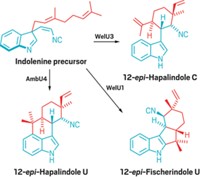Advertisement
Grab your lab coat. Let's get started
Welcome!
Welcome!
Create an account below to get 6 C&EN articles per month, receive newsletters and more - all free.
It seems this is your first time logging in online. Please enter the following information to continue.
As an ACS member you automatically get access to this site. All we need is few more details to create your reading experience.
Not you? Sign in with a different account.
Not you? Sign in with a different account.
ERROR 1
ERROR 1
ERROR 2
ERROR 2
ERROR 2
ERROR 2
ERROR 2
Password and Confirm password must match.
If you have an ACS member number, please enter it here so we can link this account to your membership. (optional)
ERROR 2
ACS values your privacy. By submitting your information, you are gaining access to C&EN and subscribing to our weekly newsletter. We use the information you provide to make your reading experience better, and we will never sell your data to third party members.
Synthesis
Polypropionates via asymmetric catalysis
May 29, 2006
| A version of this story appeared in
Volume 84, Issue 22
The ability to use different catalysts to obtain complementary stereochemical outcomes in the catalytic asymmetric synthesis of polypropionates has been demonstrated by Scott G. Nelson and coworkers of the University of Pittsburgh (J. Am. Chem. Soc. 2006, 128, 7438). The researchers developed the alkaloid-catalyzed acyl halide-aldehyde cyclocondensation reaction several years ago. They have now extended its applicability to the catalytic asymmetric synthesis of repeating propionate units, which are commonly found in polyketides and other natural products. They demonstrated the reaction's potential by using it to carry out the catalytic asymmetric synthesis of (-)-pironetin (shown), a polyketide with immunosuppressive and anticancer activities. "There are very few reactions in asymmetric catalysis that are effective enough to allow use in the synthesis of stereochemically complex targets," says Eric N. Jacobsen of Harvard University of the polypropionate reaction.





Join the conversation
Contact the reporter
Submit a Letter to the Editor for publication
Engage with us on Twitter